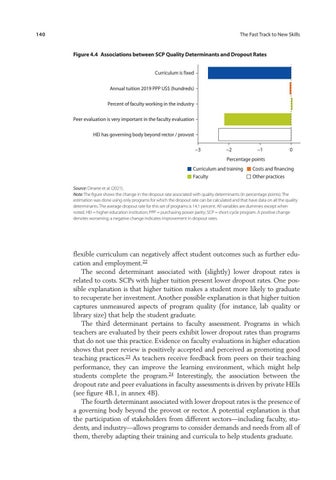140
The Fast Track to New Skills
Figure 4.4 Associations between SCP Quality Determinants and Dropout Rates Curriculum is fixed Annual tuition 2019 PPP US$ (hundreds) Percent of faculty working in the industry Peer evaluation is very important in the faculty evaluation HEI has governing body beyond rector / provost −3
−2
−1
0
Percentage points Curriculum and training Faculty
Costs and financing Other practices
Source: Dinarte et al. (2021). Note: The figure shows the change in the dropout rate associated with quality determinants (in percentage points). The estimation was done using only programs for which the dropout rate can be calculated and that have data on all the quality determinants. The average dropout rate for this set of programs is 14.1 percent. All variables are dummies except when noted. HEI = higher education institution; PPP = purchasing power parity; SCP = short-cycle program. A positive change denotes worsening; a negative change indicates improvement in dropout rates.
flexible curriculum can negatively affect student outcomes such as further education and employment.22 The second determinant associated with (slightly) lower dropout rates is related to costs. SCPs with higher tuition present lower dropout rates. One possible explanation is that higher tuition makes a student more likely to graduate to recuperate her investment. Another possible explanation is that higher tuition captures unmeasured aspects of program quality (for instance, lab quality or library size) that help the student graduate. The third determinant pertains to faculty assessment. Programs in which teachers are evaluated by their peers exhibit lower dropout rates than programs that do not use this practice. Evidence on faculty evaluations in higher education shows that peer review is positively accepted and perceived as promoting good teaching practices.23 As teachers receive feedback from peers on their teaching performance, they can improve the learning environment, which might help students complete the program.24 Interestingly, the association between the dropout rate and peer evaluations in faculty assessments is driven by private HEIs (see figure 4B.1, in annex 4B). The fourth determinant associated with lower dropout rates is the presence of a governing body beyond the provost or rector. A potential explanation is that the participation of stakeholders from different sectors—including faculty, students, and industry—allows programs to consider demands and needs from all of them, thereby adapting their training and curricula to help students graduate.

